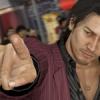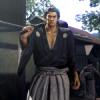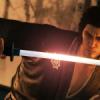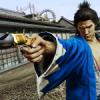With recent news that a new Yakuza game is in development, we thought now would be a great time to look back at Yakuza 2 - arguably the most-loved game in the mafia-themed sandbox action-adventure series. Going by that description alone might make Yakuza sound similar to the Rockstar’s open-world fuck-everything-up-em-up Grand Theft Auto. But the Yakuza games are a quintessentially Japanese take on the genre.
Tellingly, the Japanese use the term “hako-niwa game” or “miniature garden game” when talking about what we in the West call “sandbox” games. The implication is that someone of culture will respectfully appreciate the miniature worlds’ exacting arrangement and detailed replication. That’s not to say there isn’t plenty do in Yakuza 2’s world. Golf, Shogi and Mahjong are all on the cards (as well as, you know… card games). But the world exists primarily as a backdrop for a brooding, macho crime-drama rather than as a playground for the player’s id to run amok in.
But there’s inherent pitfalls in using a world that’s not crafted for purpose as an impromptu stage, a problem that here is compounded by crime-novelist Hase Seishuu’s script, which feels like it was penned with paperbacks, rather than a videogame, in mind.
And it’s a shame because when it’s moving along briskly, Yakuza 2’s story is the highlight of the game. The events of Yakuza 2 follow on from the original both sequentially and thematically, making the first two games in the series feel cohesive. One meme-worthy tiger punching boss fight notwithstanding, Yakuza 2 maintains a consistent vibe that’s somewhere between noir and hard-boiled - a vibe that could be characterized by twanging jazz, forlorn characters and the smell of tobacco.
Stepping into the shoes of ex-yakuza Kazama Kiryu, you find yourself having to deal with an impending full-scale war between the eastern and western yakuza organizations threatening to break out after Kiryu’s successor is assassinated. At the same time, a seemingly unrelated revenge plot unfolds behind the scenes. The story works well on several levels: Kiryu’s reluctance to be drawn back into the criminal underworld clashes with his sense of duty to rectify the situation. And then there’s Kaoru Sayama, a sassy Yakuza-hunting detective, whose prejudice against the Japanese underworld predisposes her to distrust Kiryu, even though he’s vowed to leave the Yakuza lifestyle behind – a reminder that he can’t outrun his past any more than the targets of the revenge sub-plot can outrun theirs.
It’s an engaging story that’s propped up by convincing digital acting. Characters emote with near spot-on facial expressions – ticks, subtle pupil movements and minor alterations in gaze convey surprise, suspicion and distrust in non-cartoony, subdued detail. It all contributes towards the serious vibe the game is going for.
But brilliantly acted as it is, we can’t escape the sense that Seishuu set out to write a novella rather than a videogame story. At several points plot-forwarding clues dry up, leaving the characters to wonder pointlessly—for up to 40 minutes at a time—until a plot trigger serendipitously drops into their laps. This might work in a novel where a character can stumble across revelation at the turn of a page, but it doesn’t work for a player-action-driven medium.
This kind of progression narrowly avoids falling into Deus Ex Machina territory; Kiryu and the nucleus of characters around him interact with a handful of high-profile and plot-critical characters, making their chance run-ins at least plausible, however improbable they might be. The issue here is with pacing rather than credible suspension of disbelief.
And pacing is Yakuza 2’s biggest issue. In addition to the aforementioned hours of bloat between key plot points, there’s multiple non-plot critical mandatory “side-quests”. Before all is said and done, Kiryu will stage an intervention between a tattoo artist and his errant disciple, rescue a man’s cat from gangsters and set-up a budding songstress with an idol producer.
It’s likely a lot of this content was injected to prevent the game from playing out as an exhausting compilation of cutscenes and action stages. Admittedly, it would be worse off if there was no down time at all. But Yakuza 2’s padding is not only irrelevant to the larger plot, but inefficiently doubled: We get not only one, but two sequences showing the relationship between Kiryu and his adopted daughter Haruka only hours apart from each other. Stilted pacing becomes a larger issue in the game’s second half, which is porous with filler sequences that appear in dense clusters. It’s no exaggeration to say that around one-third of Yakuza 2’s 20-hour playtime is bloat, the majority of which damages pacing more than helps it.
If there’s one positive thing to be said about Yakuza 2’s pacing, it’s that cutscenes are rarely followed with plodding text recaps on what was said or where to go next. It’s refreshing that the game trusts the player to look that information up for themselves, given that newer entries into the series are stacked to breaking point with exposition and explanation.
When Yakuza 2 was originally released it was celebrated for being a massive improvement over the original, a triumph of commonsense design. We have to agree that even today the jump in quality between the two games is still appreciably the biggest the series has seen. Gone are the original’s slow load times, sluggish menus and borderline useless map screen. Getting knocked off your feet and losing a massive chunk of your hard-earned Heat (special attack) gauge, struggling to get up as enemies unfairly wail on you, being unable to handle being attacked from multiple directions, gaming boss AI to exploitatively whittle away their life bars and struggling to line up an enemy with a wall or lamp post to trigger a face-smashing Heat attack – all the problems that mired the original Yakuza beyond redemption are nowhere to be seen.
Off the bat Kiryu can switch attack direction mid-combo, something that was reserved as a late-game high-level skill in the original. The input buffer is just about generous enough to allow combos to link smoothly without locking the player into an unabortable attack sequence, and Heat gauge penalties for being hit or downed are fairer. Defeating bosses now hinges on your ability to figure out an effective attack pattern. For example, a boss that blocks combos before counter attacking can be defeated with a combination of short combo strings and throws; it’s all about quickly figuring out what works.
But simply fixing what was broken isn’t a huge plus point when appreciating Yakuza 2 retrospectively. Yakuza 2 is certainly fairer than its predecessor, but it’s also easier in places where it needn’t be. With the exception of a few gun-toting baddies, there’s almost no need have a prioritization strategy when approaching groups of enemies - or any strategy at all, for that matter. We steamrolled our way through the game on Normal difficulty (without indulging any side-content) and met with minimal resistance.
But there’s still some good, dumb fun to be eked out from the simple, but serviceable battle system. Fighting through a dilapidated building whilst fending off a stubborn assassin multiple times transforms what would otherwise be one long grind into a humbling appreciation that your enemy is one tough customer. Yakuza 2 is at its best during these extended up-tempo action-gauntlets, so it’s unfortunate that they are few and far in number.
We’ve talked at length on Yakuza 2’s impressive cutscene presentation, but the in-game presentation is almost equally impressive. When transitioning between areas there’s a momentary pause (and slight disorientation) as new textures are loaded in, a design concession that’s necessary as, unlike the open-world GTA which re-use a limited number of textures, any given scene in Yakuza 2 is jam-packed with unique surfaces and store front signs.
This is easiest to appreciate in Soutenbori, Yakuza 2’s take on the bustling western side of Japan. Up to two dozen NPCs can be on-screen without a hint of slow down. And these NPCs aren’t placed haphazardly in random locations, either: a girl playfully punches her sweetheart, a group of office ladies wait outside office buildings and dark alleyways are populated sparsely with unsavory characters. NPCs appear to have a purpose in the world, and they all look like they could have a story of their own.
Unfortunately, the audio presentation is mixed. The same “rustling-paper” sound effect plays as characters shuffle around in their seats or move about, irrespective of their build, clothing or location. It stands at odds with the slow-mo hit sound effects which play at the close of a fight, when slowed punches have layers of bone-crunching, cartilage-rending definition to them.
Still, let your eyes adjust to the jaggy low-resolution characters and texture fuzz typical of the PlayStation 2 era, and you’ll find that Yakuza 2 is presented almost immaculately - some iffy visible seams between textures notwithstanding. In fact, we’d love to see the Japan-exclusive HD remake released on these shores, and it’s a shame that Sega hasn’t given us the opportunity.
Yakuza 2 is a veritable improvement over the original game, maintaining almost everything that worked narratively and thematically whilst revising what didn’t. And - if you adjust your expectations accordingly - its presentation is impressive. But it’s hard to celebrate it today for simply being “not bad”, especially when close to a third of the game is slow-paced filler that’s not only pointless to the plot at large, but sometimes just plain pointless. However, it still stands out for having arguably the best story in the series. That might not help it hold a candle to the newer, more refined entries in the series, but it at least makes a case for revisiting it.







